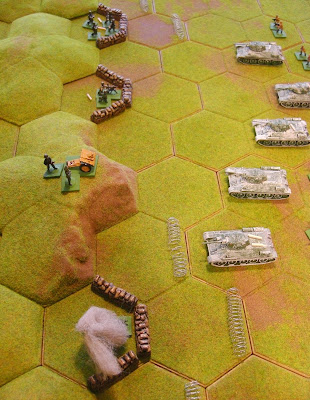I have not fought a wargame in so long that when the opportunity arose today, I seized it with both hands! Only yesterday I finished drafting a set of ‘modern’ wargames rules with the working title MEMOIR OF MODERN BATTLE, and I decided to kill two birds with one stone by play-testing the draft rules.
Scenario
After a gap of some time (almost three years!), Eastland and Morschauserland are again at war. The Eastlanders have penetrated the border with Morschauserland and are pressing forward. The Morschauserlanders have established a line of defence along a series of low hills – the Lowbrow Heights – which they have garrisoned with a weak mixture of infantry, machine guns, and artillery. The attackers outnumber the defenders and have a large number of tanks and infantry (supported by machine guns and artillery) moving towards the Heights.
Turn 1
The first wave of the Eastland attackers approached the Lowbrow Heights. They were led by a line of tanks followed by infantry and machine guns.
Turn 2
The Morschauserland infantry gun opened fire on the tank in the centre of the Eastland attackers … and forced it to retreat, much to the discomfort of the infantry that were following it, who also had to fall back!
The Eastlanders immediately reacted by moving their tanks forward and engaging the Morschauserland defences (N.B. Casualties are indicated by short lengths of matchstick).
The Morschauserlanders replied … and caused damage to quite a few of the tanks.
Turn 3
The Morschauserland infantry gun fired again on the tank in the centre of the Eastland attackers … and this time they inflicted some damage to it.
The Morschauserland defenders then opened fire on the Eastlanders … and forced two of the tanks to retreat, which also disrupted the following infantry and machine guns!
The Eastland response was to continue their advance, firing at the defenders as they did so. With the exception of one of the Morschauserland machine gun positions – which was wiped out – the rest of the fieldworks protected the defenders quite effectively, and only minor casualties were caused.
Turn 4
This time the Morschauserland infantry gun fired at one of the closest Eastland tank … and destroyed it!
The Eastlanders were not fazed by this, and continued their slow and deliberate advance, firing as they went. This proved to be a very effective tactic; the Morschauserland infantry gun was forced to fall back, the last remaining machine gun position was destroyed, and the foremost Morschauserland infantry were wiped out.
Nothing but the Morschauserland infantry gun and an infantry unit remained to stem the Eastland advance, and the Morschauserlanders withdrew to their next line of defence.
Conclusions
This was a short but sharp action in which the overwhelming strength of the attackers prevailed. The fact that it was not a complete walk over was due in no small part to the entrenchments that the Morschauserlanders had.
The play-test did point out that one or two rules that I had originally included in my development notes had not been included in the actual draft, and I will need to remedy that situation. The combat system uses the dice from Richard Borg’s MEMOIR ’44 and has a similar philosophy, and I felt that it worked very smoothly and was easy to understand. The game sequence is ‘borrowed’ from my PORTABLE WARGAME rules, which are themselves a development of Joseph Morschauser’s MODERN and FRONTIER rules. The fact that artillery gets to fire each turn before any other units gives that arm an additional feeling of importance – and possibly effect – and I felt that – to a certain extent – it countered the negative aspect of the ‘traditional’ UGO-IGO turn sequence (i.e. the lack of simultaneous fire and effect).
This play-test was a somewhat small affair, and was also rather one-sided. I would like to run another play-test at some point where the sides are rather more balanced as I suspect that the battle might last somewhat longer. In the meantime it was good to get some figures and vehicle out on the tabletop and to fight a battle. It was something that I have sorely missed in recent weeks!
Notes on unit strength values
Before I started the play-test I allocated each type of unit a strength value. This is the number of 'hits' it can sustain before it is destroyed. The strength values used in this play-test were as follows:
- Infantry = 4
- Machine Guns = 2
- Artillery = 2
- Tanks = 3
I made no allowance for unit quality when I did this, but it would be relatively easy to reflect the differences in unit quality by increasing the strength value of elite units by one or even two, and reducing the strength value of poor quality units by one.


































































.jpeg)
















